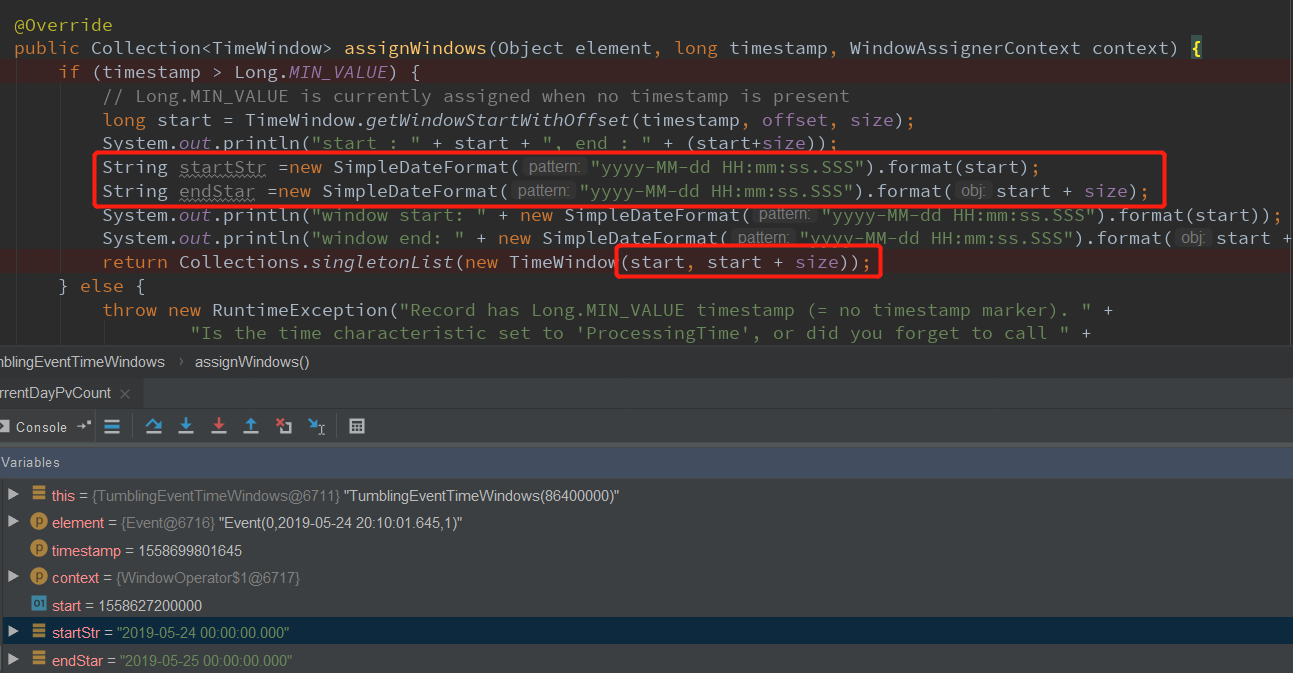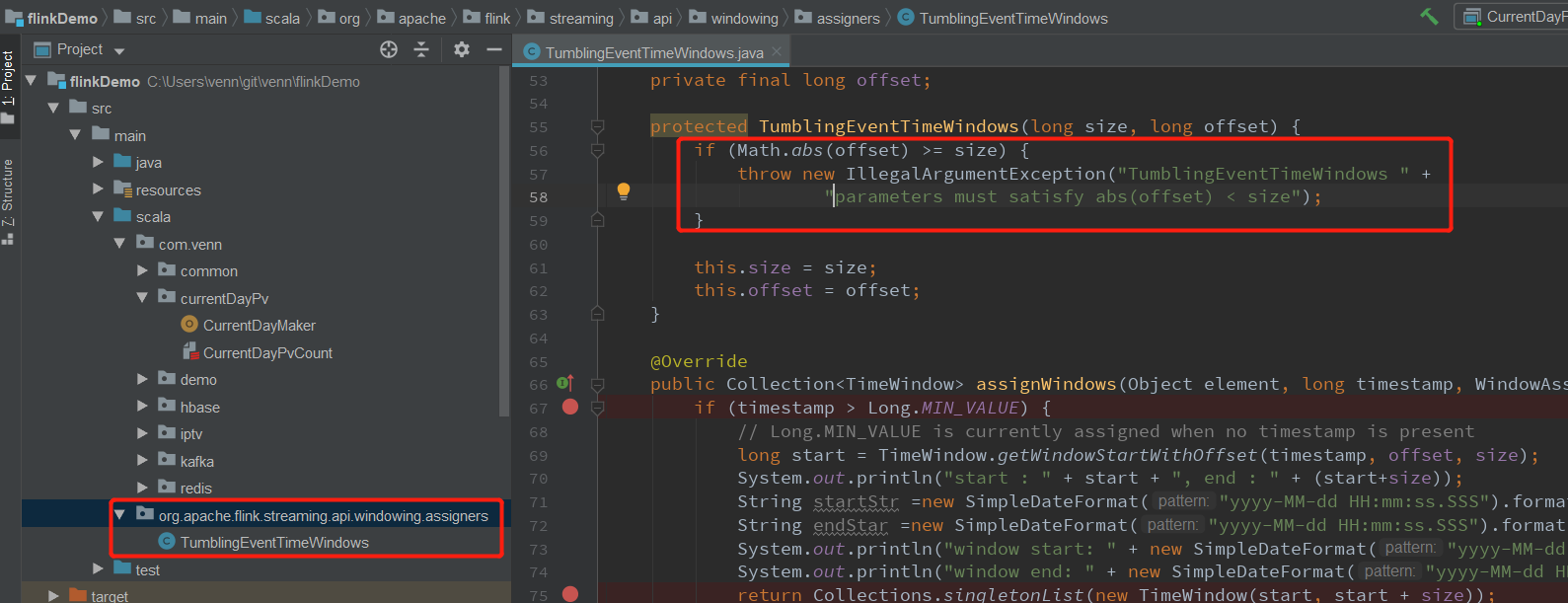Flink 统计当日的UV、PV
测试环境:
flink 1.7.2
1、数据流程

a.模拟数据生成,发送到kafka(json 格式)
b.flink 读取数据,count
c. 输出数据到kafka(为了方便查看,输出了一份到控制台)
2、模拟数据生成器
数据格式如下 : {"id" : 1, "createTime" : "2019-05-24 10:36:43.707"}
id 为数据生成的序号(累加),时间为数据时间(默认为数据生成时间)

模拟数据生成器代码如下:
/** * test data maker */ object CurrentDayMaker { var minute : Int = 1 val calendar: Calendar = Calendar.getInstance() /** * 一天时间比较长,不方便观察,将时间改为当前时间, * 每次累加10分钟,这样一天只需要144次循环,也就是144秒 * @return */ def getCreateTime(): String = { // minute = minute + 1 calendar.add(Calendar.MINUTE, 10) sdf.format(calendar.getTime) } val sdf = new SimpleDateFormat("yyyy-MM-dd HH:mm:ss.SSS") def main(args: Array[String]): Unit = { val producer = new KafkaProducer[String, String](Common.getProp)
// 初始化开始时间为当前时间 calendar.setTime(new Date()) println(sdf.format(calendar.getTime)) var i =0; while (true) { // val map = Map("id"-> i, "createTime"-> sdf.format(System.currentTimeMillis())) val map = Map("id"-> i, "createTime"-> getCreateTime()) val jsonObject: JSONObject = new JSONObject(map) println(jsonObject.toString()) // topic current_day val msg = new ProducerRecord[String, String]("current_day", jsonObject.toString()) producer.send(msg) producer.flush()
// 控制数据频率 Thread.sleep(1000) i = i + 1 } } }
生成数据如下:
{"id" : 0, "createTime" : "2019-05-24 18:02:26.292"}
{"id" : 1, "createTime" : "2019-05-24 18:12:26.292"}
{"id" : 2, "createTime" : "2019-05-24 18:22:26.292"}
{"id" : 3, "createTime" : "2019-05-24 18:32:26.292"}
{"id" : 4, "createTime" : "2019-05-24 18:42:26.292"}
3、flink 程序
/** * Created by venn on 19-5-23. * * use TumblingEventTimeWindows count current day pv * for test, update day window to minute window * * .windowAll(TumblingEventTimeWindows.of(Time.minutes(1), Time.seconds(0))) * TumblingEventTimeWindows can ensure count o minute event, * and time start at 0 second (like : 00:00:00 to 00:00:59) * */ object CurrentDayPvCount { def main(args: Array[String]): Unit = { // environment val env: StreamExecutionEnvironment = StreamExecutionEnvironment.getExecutionEnvironment env.setStreamTimeCharacteristic(TimeCharacteristic.EventTime) env.setParallelism(1) val topic = "current_day" val sdf = new SimpleDateFormat("yyyy-MM-dd HH:mm:ss.SSS") val kafkaSource = new FlinkKafkaConsumer[ObjectNode](topic, new JsonNodeDeserializationSchema(), Common.getProp) val sink = new FlinkKafkaProducer[String](topic + "_out", new SimpleStringSchema(), Common.getProp) sink.setWriteTimestampToKafka(true) val stream = env.addSource(kafkaSource) .map(node => { Event(node.get("id").asText(), node.get("createTime").asText()) }) .assignAscendingTimestamps(event => sdf.parse(event.createTime).getTime) // 1分钟的window,默认offset 为 0 毫秒 //.windowAll(TumblingEventTimeWindows.of(Time.minutes(1))) // 1小时的window,默认offset 为 0 // .windowAll(TumblingEventTimeWindows.of(Time.hours(1))) // 一天的窗口,从 0 点开始, 这里有个bug(FLINK-11326), offset 不能使用负数, 1.8 修复 .windowAll(TumblingEventTimeWindows.of(Time.days(1), Time.hours(-8))) // 触发器事件时间,一分钟输出一次(这里有个问题: 窗口结束不会触发窗口函数(reduce),可能会漏数据;
// 如触发时间上一次是 23:59:00,下一次时间是 下一天的 00:01:00,23:59到 00:00 的数据会丢失) // .trigger(ContinuousEventTimeTrigger.of(Time.seconds(60))) // 触发器处理时间,一分钟输出一次,处理时间与事件时间有类似的问题 // .trigger(ContinuousProcessingTimeTrigger.of(Time.seconds(60))) // 触发器,多少条数据触发一次 .trigger(CountTrigger.of(1)) .reduce(new ReduceFunction[Event] { override def reduce(event1: Event, event2: Event): Event = { // 将结果中,id的最小值和最大值输出 new Event(event1.id , event2.id , event1.count + event2.count) } }) stream.print("result : ") // execute job env.execute("CurrentDayCount") } } case class Event(id: String, createTime: String, count: Int = 1) {}
4、运行结果
测试数据如下:
{"id" : 0, "createTime" : "2019-05-24 20:29:49.102"}
{"id" : 1, "createTime" : "2019-05-24 20:39:49.102"}
...
{"id" : 20, "createTime" : "2019-05-24 23:49:49.102"}
{"id" : 21, "createTime" : "2019-05-24 23:59:49.102"}
{"id" : 22, "createTime" : "2019-05-25 00:09:49.102"}
{"id" : 23, "createTime" : "2019-05-25 00:19:49.102"}
...
{"id" : 163, "createTime" : "2019-05-25 23:39:49.102"}
{"id" : 164, "createTime" : "2019-05-25 23:49:49.102"}
{"id" : 165, "createTime" : "2019-05-25 23:59:49.102"}
{"id" : 166, "createTime" : "2019-05-26 00:09:49.102"}
...
{"id" : 308, "createTime" : "2019-05-26 23:49:49.102"}
{"id" : 309, "createTime" : "2019-05-26 23:59:49.102"}
{"id" : 310, "createTime" : "2019-05-27 00:09:49.102"}
0 - 21 是 24号
22 - 165 是 25 号
166 - 309 是 26 号
输出结果(程序中reduce 方法,将窗口中第一条和最后一条数据的id,都放到 Event中 )如下:

与测试数据对应
5、说明
很多人会错误的以为,窗口时间的开始时间会是程序启动(初始化)的时间。事实上,窗口(以TumblingEventTimeWindows为例)的定义有两个重载的方法:包含两个参数,窗口的长度和窗口的offset(默认为0)
源码:org.apache.flink.streaming.api.windowing.assigners.TumblingEventTimeWindows :
@PublicEvolving public class TumblingEventTimeWindows extends WindowAssigner<Object, TimeWindow> { private static final long serialVersionUID = 1L; private final long size; private final long offset; protected TumblingEventTimeWindows(long size, long offset) { if (Math.abs(offset) >= size) { throw new IllegalArgumentException("TumblingEventTimeWindows parameters must satisfy abs(offset) < size"); } this.size = size; this.offset = offset; } @Override public Collection<TimeWindow> assignWindows(Object element, long timestamp, WindowAssignerContext context) { if (timestamp > Long.MIN_VALUE) { // Long.MIN_VALUE is currently assigned when no timestamp is present long start = TimeWindow.getWindowStartWithOffset(timestamp, offset, size); System.out.println("start : " + start + ", end : " + (start+size)); String startStr =new SimpleDateFormat("yyyy-MM-dd HH:mm:ss.SSS").format(start); String endStar =new SimpleDateFormat("yyyy-MM-dd HH:mm:ss.SSS").format(start + size); System.out.println("window start: " + new SimpleDateFormat("yyyy-MM-dd HH:mm:ss.SSS").format(start)); System.out.println("window end: " + new SimpleDateFormat("yyyy-MM-dd HH:mm:ss.SSS").format(start + size)); return Collections.singletonList(new TimeWindow(start, start + size)); } else { throw new RuntimeException("Record has Long.MIN_VALUE timestamp (= no timestamp marker). " + "Is the time characteristic set to 'ProcessingTime', or did you forget to call " + "'DataStream.assignTimestampsAndWatermarks(...)'?"); } }/** * Creates a new {@code TumblingEventTimeWindows} {@link WindowAssigner} that assigns * elements to time windows based on the element timestamp. * * @param size The size of the generated windows. * @return The time policy. */ public static TumblingEventTimeWindows of(Time size) { return new TumblingEventTimeWindows(size.toMilliseconds(), 0); } /** * Creates a new {@code TumblingEventTimeWindows} {@link WindowAssigner} that assigns * elements to time windows based on the element timestamp and offset. * * <p>For example, if you want window a stream by hour,but window begins at the 15th minutes * of each hour, you can use {@code of(Time.hours(1),Time.minutes(15))},then you will get * time windows start at 0:15:00,1:15:00,2:15:00,etc. * * <p>Rather than that,if you are living in somewhere which is not using UTC±00:00 time, * such as China which is using UTC+08:00,and you want a time window with size of one day, * and window begins at every 00:00:00 of local time,you may use {@code of(Time.days(1),Time.hours(-8))}. * The parameter of offset is {@code Time.hours(-8))} since UTC+08:00 is 8 hours earlier than UTC time. * * @param size The size of the generated windows. * @param offset The offset which window start would be shifted by. * @return The time policy. */ public static TumblingEventTimeWindows of(Time size, Time offset) { return new TumblingEventTimeWindows(size.toMilliseconds(), offset.toMilliseconds()); } }
每条数据都会触发: assignWindows 方法
计算函数如下:
public static long getWindowStartWithOffset(long timestamp, long offset, long windowSize) { return timestamp - (timestamp - offset + windowSize) % windowSize; }
dubug 如下:

6、特别说明
FLink 1.6.3/1.7.1/1.7.2 在 TumblingEventTimeWindows 构造器上有个bug:offset 不能小于0, 但是of 方法中又说明,可以使用: of(Time.days(1),Time.hours(-8)) 表示在中国的 0 点开始的一天窗口。
JIRA : FLINK-11326 ,jira 上注明1.8.0 修复。(我本来准备提个bug的,有人先下手了)
这个bug 可以通过自己创建一个相同包的相同类,将对应代码修改即可。
flink 1.7.2 源码:
protected TumblingEventTimeWindows(long size, long offset) { if (offset < 0 || offset >= size) { throw new IllegalArgumentException("TumblingEventTimeWindows parameters must satisfy 0 <= offset < size"); } this.size = size; this.offset = offset; }
最新版源码:
protected TumblingEventTimeWindows(long size, long offset) { if (Math.abs(offset) >= size) { throw new IllegalArgumentException("TumblingEventTimeWindows parameters must satisfy abs(offset) < size"); } this.size = size; this.offset = offset; }
修改:
